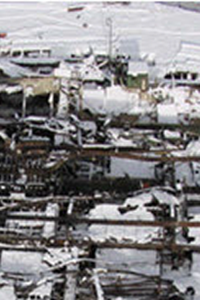Explosion and fire at sawmill in Burns Lake
Date of incident: January 2012
Notice of incident number: 2012161980018
Employer: Babine Forest Products Limited
Incident summary
During the afternoon shift, there was an explosion at the Babine Forest Products sawmill. A large fireball burst through the roof at the northeast side of the mill, while the explosion travelled east to west through the operating and basement levels. Fire spread throughout the premises, completely destroying the mill. Two workers were killed in the explosion and 20 others were injured.
Investigation conclusions
Causes
- Concentration of dispersed wood dust in the air: The wood dust that was dispersed in the air within the Babine sawmill was of sufficient concentration to explode. The wood dust was the fuel for the explosion.
- Friction within the motor-reducer V-belt guard provided ignition source: Wood dust from beneath a conveyor migrated into the confined area within the motor-reducer V-belt guard. The dust was compacted and subjected to near-constant friction from the rotating belts and sheaves. This dust caught fire and ignited the airborne wood dust that was dispersed in the area. An explosion and subsequent fire travelled through the mill, disturbing and dispersing the accumulated wood dusts and setting off secondary deflagrating explosions that totally destroyed the mill, killing two workers and injuring 20, many seriously.
- Ineffective wood dust control measures: The dust collection system was ineffective in controlling airborne dusts and the accumulation of other fine dusts in the sawmill. The collection ducting did not service all the areas where these dusts were being produced. An effective dust collection system should capture the dust at the point of release and transport the material through ducting into collection equipment. In addition, wood waste was not adequately removed from the mill during production shifts. It provided fuel for the explosion and subsequent fires.
- Ineffective inspection and maintenance system: The application of a nearly solid guard at the motor-reducer assembly's location required increased inspection and maintenance to ensure that the containment it presented was adequately monitored and controlled. This was not being done.
- Conditions of the wood and weather: Cold weather conditions resulted in a very dry environment with low humidity. This condition was compounded by the very dry beetle-killed wood. The dusts produced were drier and finer and they migrated throughout the mill. These dusts were mixed with green wood dusts as green wood was being processed concurrently. The very dry environment, low humidity, and dust conditions contributed to this incident.
- Waste conveyor configurations increased airborne wood dust: Waste conveyors in the basement level did not adequately capture the fine dust generated during lumber processing. These conveyors were open to the operating floor above and there were large open areas along the conveyor sidewalls. Wood waste was dropped from one conveyor to another, accompanied by vibration in some cases. The conveyors were not equipped with an effective dust collection system. Fine wood dust stirred up by the constant action of the conveyors was free to disperse into the air. Only some of the conveyors had dust collection ducting and even then it did not effectively capture the fine dust. This fine dust should have been removed independent of the waste conveyor system. The volume of the coarser wood dust and debris exceeded the capacity of the conveyor system.
- Inadequate supervision of clean-up and maintenance staff: Accumulations of wood waste before the explosion and the poor condition of some of the electrical equipment that was inspected after the incident indicate that supervisors were not effectively or adequately monitoring the work that was being done.
Hazard alert
2021-04-22 20:42:33

